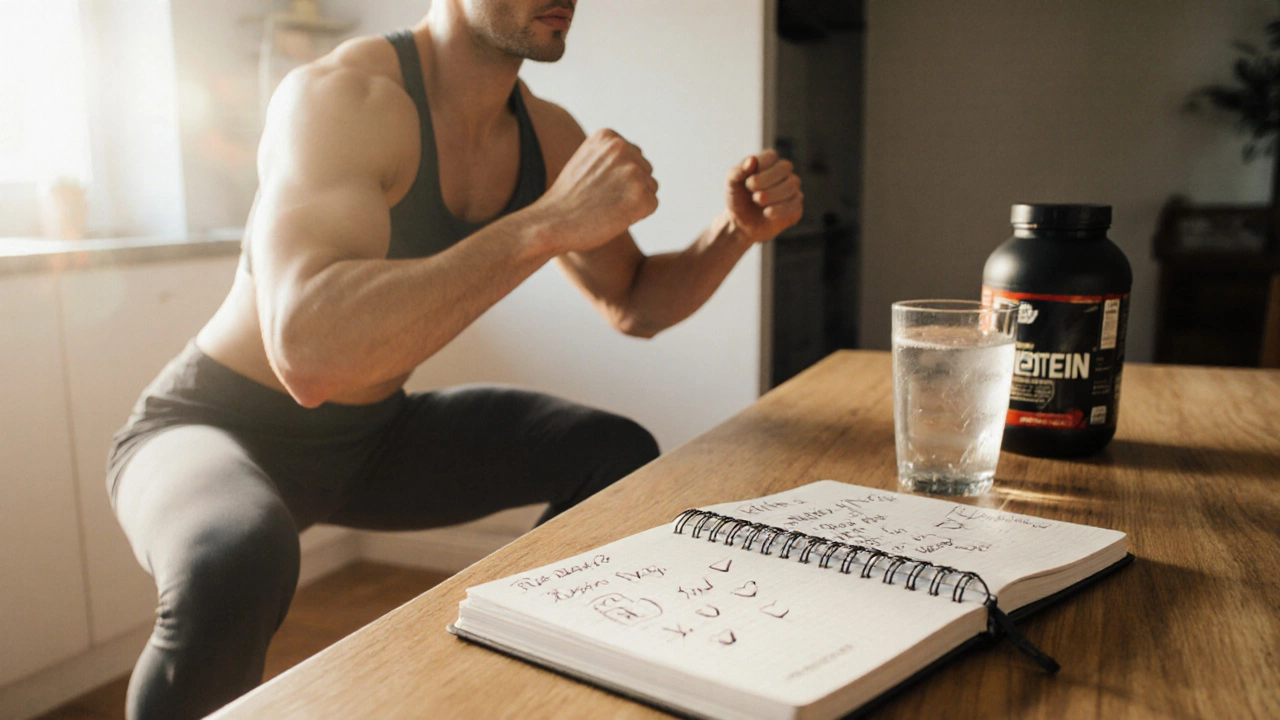Squat Goal Calculator
Choose Your Fitness Goal
Important Safety Note: If you experience knee pain or lower back strain, reduce weight or reps immediately. Never sacrifice form for numbers.
When it comes to building lower‑body strength, Squats are a fundamental compound movement that targets the quadriceps, glutes, and hamstrings while also engaging core stabilizers. People ask the same question over and over: how many of them should you do each day? The answer isn’t a one‑size‑fits‑all number; it depends on your goal, fitness level, and how you structure the rest of your training.
Key Takeaways
- For pure strength, aim for 3‑5 sets of 3‑6 reps at high load.
- For muscle growth (hypertrophy), 3‑4 sets of 8‑12 reps works best.
- Endurance or conditioning calls for 2‑3 sets of 15‑25 reps with lighter weight.
- Progressively overload - add weight, reps, or sets each week.
- Never sacrifice form; quality always beats quantity.
Understanding Your Goal Shapes the Rep Range
Different goals require different Repetition range the number of reps you perform per set. Strength athletes train low reps with heavy loads to improve neural efficiency. Bodybuilders target moderate reps to cause muscle fatigue and stimulate growth. Endurance athletes keep the reps high and the load light to boost muscular stamina.
How Many daily squats for Strength?
If your main aim is to lift heavier in the gym, keep the volume modest but intense. A typical protocol is 3-5 sets of 3-6 reps at ~80‑85% of your one‑rep max (1RM). That translates to roughly 15‑30 squats per session. Doing this 3‑4 times a week gives enough stimulus while allowing recovery.
How Many Squats for Hypertrophy?
For muscle size, you need enough time under tension to break down fibers. Most lifters find 8‑12 reps per set at 65‑75% of 1RM effective. Performing 3‑4 sets means 24‑48 squats per workout. Spread across 3 sessions a week, you’re looking at 70‑150 squats per day on average, but the true “daily” count is the sum of each training day’s volume.

How Many Squats for Endurance?
Endurance work focuses on high‑rep, low‑load sets. Think 2‑3 sets of 15‑25 bodyweight squats. That’s 30‑75 reps per session. If you’re doing a quick “every‑day” routine, 30‑50 squats can be enough to keep the muscles primed without overtraining.
Progressive Overload: The Engine That Drives Results
Regardless of goal, growth stops when the stimulus stays the same. Progressive overload the systematic increase of training stress can be applied in three ways: add weight, add reps, or add sets. A simple method is the “2‑plus‑1” rule - each week, add 2 reps to each set, and once you hit the top of the rep range, add a small weight increase (2‑5 kg) and drop back down.
Form First: Avoiding Common Squat Injuries
Bad technique is the #1 reason people quit squatting. Keep these checkpoints in mind:
- Quadriceps the front thigh muscles that extend the knee should stay engaged throughout the descent.
- Gluteus maximus the main hip extensor that powers the stand‑up must finish the movement.
- Maintain a neutral spine; avoid rounding the lower back.
- Knees should track over the toes, not collapse inward.
Recovery: Why Rest Days Matter
Even though squats are “just a movement,” they stress large muscle groups and the nervous system. For strength, a 48‑hour gap between heavy squat sessions is essential. Hypertrophy can tolerate 24‑48 hours, while endurance work often allows daily low‑intensity squats. Sleep, nutrition, and foam‑rolling help replenish muscle glycogen and repair micro‑tears.

Sample Weekly Plans
Below are three templates you can copy‑paste into a calendar. Adjust the weight and rep scheme based on the goal you identified.
| Goal | Reps per Set | Sets per Session | Total Daily Reps (approx.) |
|---|---|---|---|
| Strength | 3‑6 | 3‑5 | 15‑30 (heavy load) |
| Hypertrophy | 8‑12 | 3‑4 | 24‑48 (moderate load) |
| Endurance | 15‑25 | 2‑3 | 30‑75 (bodyweight or light) |
Tracking Your Progress
Use a simple notebook or an app to log three numbers each session: weight used, reps completed, and sets performed. When you hit a plateau for two weeks, revisit the overload rule. Consistency beats occasional high‑volume spikes.
Common Questions and Quick Fixes
- Can I do squats every single day? Yes, if you keep the load light and focus on technique. Heavy days need rest.
- Should I warm up before every squat set? A 5‑minute dynamic warm‑up (leg swings, hip circles) prepares the Hamstrings the back thigh muscles that control knee flexion and hips for safe loading.
- Do I need a barbell? Bodyweight works for endurance; dumbbells or kettlebells are great for moderate loads; a barbell is ideal for strength and hypertrophy.
Next Steps: Building a Sustainable Habit
Pick a goal, choose the matching template, and set a reminder for your squat time. Start with a weight you can move confidently for the full rep range. After four weeks, reassess - you’ll likely need to add weight or reps. Remember, the best number of squats is the number that keeps you moving forward without hurting yourself.
How many squats can a beginner do safely each day?
A complete beginner should start with 2‑3 sets of 8‑10 bodyweight squats, totaling 20‑30 reps, performed 3‑4 times a week. This builds technique and joint strength before adding load.
Is it better to do more squats with less weight or fewer squats with more weight?
It depends on your goal. For strength, fewer reps with heavier weight are optimal. For muscle size, moderate weight with 8‑12 reps works best. For endurance, high reps with light weight are preferred.
Can daily squats improve my posture?
Yes, squats strengthen the posterior chain (glutes, hamstrings, lower back) which supports an upright posture. Consistent, well‑performed squats can counteract sitting‑induced forward‑leaning.
How long should I rest between squat sets?
For strength sets (3‑6 reps), rest 2‑3 minutes. For hypertrophy (8‑12 reps), rest 60‑90 seconds. For endurance (15+ reps), 30‑60 seconds is sufficient.
Should I stretch after doing squats?
A brief static stretch of the quadriceps, hamstrings, and hip flexors (15‑30 seconds each) can aid recovery, but the most important post‑workout routine is foam‑rolling and adequate protein intake.
